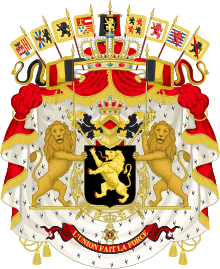Àmì ọ̀pá àṣẹ ilẹ̀ Bẹ́ljíọ̀m
Ìrísí
| Àmì ọ̀pá àṣẹ ilẹ̀ Bẹ́ljíọ̀m | |
|---|---|
 Greater version | |
| Ẹ̀kúnrẹ́rẹ́ | |
| Ọ̀pá àṣẹ | Albert II, King of the Belgians |
| Lílò | 17 March 1837 |
| Crest | A helmet with raised visor or crowned with a Royal Crown of Belgium |
| Escutcheon | Sable, a lion rampant or, armed and langued Gules with two crossed sceptres (a hand of justice and a lion) or behind a shield. The grand collar of the Order of Leopold (Belgium) surrounds the shield |
| Supporters | Two lions guardant proper each supporting a lance Gules point or with two National Flags of Belgium (Tierced per pale Sable, or and Gules. |
| Compartment | Underneath the compartment is placed the ribbon Gules with two stripes Sable charged with the motto |
| Motto | Faransé: L'union fait la force Duki: Eendracht maakt macht |
| Orders | Order of Leopold |
| Other elements | The whole is placed on a mantle Gules with ermine lining, fringes and tassels Or and ensigned with the Royal Crown of Belgium. Above the mantle rise banners with the arms of the nine provinces that constituted Belgium in 1837. They are (from dexter to sinister) Antwerp, West Flanders, East Flanders, Liège, Brabant, Hainaut, Limburg, Luxembourg and Namur |
Àmì ọ̀pá àṣẹ ilẹ̀ Bẹ́ljíọ̀m je ti orile-ede Bẹ́ljíọ̀m.

|
Àyọkà yìí tàbí apá rẹ̀ únfẹ́ àtúnṣe sí. Ẹ le fẹ̀ jù báyìí lọ tàbí kí ẹ ṣàtúnṣe rẹ̀ lọ́nà tí yíò mu kúnrẹ́rẹ́. Ẹ ran Wikipedia lọ́wọ́ láti fẹ̀ẹ́ jù báyìí lọ. |
